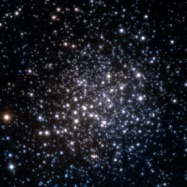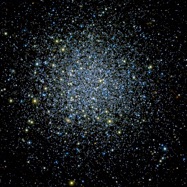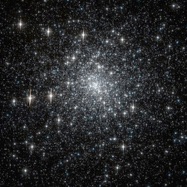


WELCOME TO




Light-on-Dark web page
LIGHT-ON-DARK proposes a comprehensive approach to the determination of the physical processes setting the properties of star clusters and their evolution accross the cosmic time. To achieve this goal, LIGHT-ON-DARK proposes a full kinematical and spectro-photometric study of massive stellar systems in the Milky Way and of their sub-populations. In particular, via an innovative combination of accurate multi-band photometry and multi-instrument spectroscopy of individual stars and proper motion measurements with HST and Gaia, we will obtain the full characterization of the stellar populations and the 3D view of the velocity space for a representative sample of 40 Galactic globular clusters (GGCs). This crucial information, coupled with a new generation of star density profiles, dynamical models and N-body simulations, will provide new knowledge in several areas of modern Astrophysics and Cosmology going well beyond the specific domain of GGC studies. In fact, in addition to filling the current lack of knowledge about the physics of collisional stellar systems, LIGH-ON-DARK will put the final word on the problem of the existence of the so-called intermediate-mass black holes (with crucial impact on our comprehension of the formation processes of super massive black holes, observed in galaxies already at redshift z>6)
Published papers
2019
-
1. High-resolution Extinction Map in the Direction of the Bulge Globular Cluster NGC 6440, Pallanca et al., 2019, ApJ, 882, 159
-
2. A Family Picture: Tracing the Dynamical Path of the Structural Properties of Multiple Populations in Globular Clusters, Dalessandro et al., 2019, ApJL, 884, L24
2020
-
3. The "dynamical clock": dating the internal dynamical evolution of star clusters with Blue Straggler Stars, Ferraro et al., 2020, Rendiconti dei Lincei, Scienze Fisiche e Naturali - Lincei Prizewinner, Vol. 31, p. 19-31
-
4. A Kinematic View of NGC 1261: Structural Parameters, Internal Dispersion, Absolute Proper Motion, and Blue Straggler Stars, Raso et al., 2020, ApJ, 895, 15
-
5. Digging for Relics of the Past: The Ancient and Obscured Bulge Globular Cluster NGC 6256, Cadelano et al., 2020, ApJ, 895, 54
-
6. PSR J1641+3627F: A Low-mass He White Dwarf Orbiting a Possible High-mass Neutron Star in the Globular Cluster M13, Cadelano et al., 2020, ApJ, 905, 63
-
7. Radial variation of the stellar mass functions in the globular clusters M15 and M30: clues of a non-standard IMF?, Cadelano et al., 2020, MNRAS 499, 2390
-
8. Is Fornax 4 the nuclear star cluster of the Fornax dwarf spheroidal galaxy?, Martocchia et al., 2020, MNRAS 495, 4518
2021
-
9. On the Nitrogen variation in 2 Gyr old massive star clusters in the large Magellanic Cloud, Martocchia et al., 2021, MNRAS 505, 5389
-
10. 3D core kinematics of NGC 6362: central rotation in a dynamically evolved globular cluster, Dalessandro et al., 2021, MNRAS 506, 813
-
11. Early dynamics and violent relaxation of multimass rotating star clusters, Livernois et al., 2021, MNRAS 506, 5781
-
12. First Phase Space Portrait of a Hierarchical Stellar Structure in the Milky Way, Dalessandro et al., 2021, ApJ 909, 90
-
13. A New Identity Card for the Bulge Globular Cluster NGC 6440 from Resolved Star Counts, Pallanca et al., 2021, ApJ, 913, 137
-
14. High-resolution Extinction Map in the Direction of the Strongly Obscured Bulge Fossil Fragment Liller 1, Pallanca et al., 2021, ApJ, 917, 92
-
15. A New Set of Chisels for Galactic Archeology: Sc, V, and Zn as Taggers of Accreted Globular Clusters, Minelli et al., 2021, ApJ, 918, L32
-
16. Stellar population astrophysics (SPA) with the TNG. The Arcturus Lab, Fanelli et al., 2021, A&A 645, 19
-
17. A Homogeneous Comparison between the Chemical Composition of the Large Magellanic Cloud and the Sagittarius Dwarf Galaxy, Minelli et al., 2021, AJ, 910, 114
-
18. A new class of fossil fragments from the hierarchical assembly of the Galactic bulge, Ferraro et al., 2021, Nat. Astro., 5, 311
-
19. Slowly cooling white dwarfs in M13 from stable hydrogen burning, Chen et al., 2021, Nat. Astro., 5, 1170
-
20. A relic from a past merger event in the Large Magellanic Cloud, Mucciarelli et al., 2021, Nat. Astro., 5, 1247
2022
-
21. Expanding the Time Domain of Multiple Populations: Evidence of Nitrogen Variations in the∼1.5 Gyr Old Star Cluster NGC 1783, Cadelano et al., 2022, ApJL, 924, L2
-
22. Searching for New Observational Signatures of the Dynamical Evolution of Star Clusters, Bhat et al., 2022, ApJ, 926, 118
-
23. Blue Stragglers as Tracers of the Dynamical State of Two Clusters in the Small Magellanic Cloud: NGC 339 and NGC 419, Dresbach et al., 2022, ApJ, 928, 47
-
24. Stellar population astrophysics (SPA) with the TNG. The chemical content of the red supergiant population in the Perseus complex, Fanelli et al., 2022, A&A, 660, A7
-
25. The ESO-VLT MIKiS Survey Reloaded: Velocity Dispersion Profile and Rotation Curve of NGC 1904, Leanza et al., 2022, ApJ, 929, 186
-
26. Lithium Detection in Red Supergiant Stars of the Perseus Complex, Fanelli et al., 2022, ApJ, 931, 61
-
27. Slowly Cooling White Dwarfs in NGC 6752, Chen et al., 2022, ApJ, 934, 93
-
28. The Hubble Space Telescope UV Legacy Survey of Galactic Globular Clusters. XXIII. Proper-motion Catalogs and Internal Kinematics, Libralato et al., 2022, ApJ, 934, 150
-
29. Clues to the Formation of Liller 1 from Modeling Its Complex Star Formation History, Dalessandro et al., 2022, ApJ, 940, 170
-
30. Discovery of a Double Sequence of Blue Straggler Stars in the Core-collapsed Globular Cluster NGC 6256, Cadelano et al., 2022, ApJ, 941, 69
2023
-
31. Digging into the Galactic Bulge: Stellar Population and Structure of the Poorly Studied Cluster NGC 6316, Deras et al., 2023, ApJ, 942, 104
-
32. Dynamical state of the globular clusters Rup 106 and IC 4499, Beccari et al., 2023, A&A, 670, A11
-
33. The ESO-VLT MIKiS Survey Reloaded: Exploring the Internal Kinematics of NGC 6440, Leanza et al., 2023, ApJ, 944, 162
-
34. The chemical DNA of the Magellanic CloudsI. The chemical composition of 206 Small Magellanic Cloud red giant stars, Mucciarelli et al., 2023, A&A, 671, A124
-
35. New Parameters for Star Cluster Dynamics: The Effect of Primordial Binaries and Dark Remnants, Bhat et al., 2023, ApJ, 945, 164
-
36. A Young White Dwarf Orbiting PSR J1835−3259B in the Bulge Globular Cluster NGC 6652, Chen et al., 2023, ApJ, 948, 84
-
37. Fast rotating blue stragglers prefer loose clusters, Ferraro et al., 2023, Nat. Communications, 14, 2584
-
38. Ongoing hierarchical massive cluster assembly: The LISCA II structure in the Perseus complex, Della Croce et al., 2023, A&A, 674, A93
-
39. Internal Kinematics and Structure of the Bulge Globular Cluster NGC 6569, Pallanca et al., 2023, ApJ, 950, 138
-
40. Empirical Measurement of the Dynamical Ages of Three Globular Clusters and Some Considerations on the Use of the Dynamical Clock, Ferraro et al., 2023, ApJ, 950, 145
-
41. The “Canonical” White Dwarf Cooling Sequence of M5, Chen et al., 2023, ApJ, 950, 155
-
42. First Evidence of Multi-iron Subpopulations in the Bulge Fossil Fragment Candidate Liller 1, Crociati et al., 2023, ApJ, 951, 17
-
43. Modeling the Chemical Enrichment History of the Bulge Fossil Fragment Terzan 5, Romano et al., 2023, ApJ, 951, 85
-
44. An Ongoing Tidal Capture in the Large Magellanic Cloud: The Low-mass Star Cluster KMK 88-10 Captured by the Massive Globular Cluster NGC 1835?, Giusti et al., 2023, ApJ, 953, 125
-
45. The chemical DNA of the Magellanic Clouds II. High-resolution spectroscopy of the SMC globular clusters NGC 121, NGC 339, and NGC 41, Mucciarelli et al., 2023, A&A, 677, A61
-
46. Fast-rotating Blue Straggler Stars in the Globular Cluster NGC 3201, Billi et al., 2023, ApJ, 956, 124
-
47. The structural properties of multiple populations in the dynamically young globular cluster NGC 2419, Onorato et al., 2023, A&A, 677, A8
-
48. Extended main-sequence turnoff and red clump in intermediate-age star clusters: A study of NGC 419, Dresbach et al., 2023, A&A, 679, A102
-
49. JWST uncovers helium and water abundance variations in the bulge globular cluster NGC 6440, Cadelano et al., 2023, A&A, 679, L13
-
50. Young, wild and free: the early expansion of star clusters, Della Croce et al., 2023, A&A